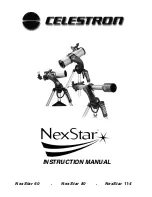
13
To move the telescope towards a desired object in the sky there are two options.
1.
For large and quick movements, loosen the altitude and azimuth locks by rotating the knobs counterclockwise and
manually moving the telescope tube towards your desired object. You should roughly align the selected object
with the red dot as seen through the Star Pointer finderscope. (For further instruction on using the Star Pointer, see
the Assembly section earlier in this manual). Tighten the locking knobs when you are near the position you want.
Do not tighten down the locking knob all the way; only enough so that the telescope tube will not move on its
own.
2.
For very small movements and fine adjustments, use the motion control wheels on each axis. Hold the telescope
fork arm with your hands and rotate each motion control wheel slowly with your thumbs. If the wheel is tight and
difficult to move, loosen the clutch knobs slightly until the telescope moves freely.
3.
Move the telescope until the desired star or object is aligned with the Star Pointer and visible in the eyepiece.
Tighten down the locking knobs completely to secure the telescope on the object.
The telescope should be properly balanced in order for it to move smoothly in both axes:
1.
To balance the telescope tube in altitude, loosen the altitude locking knob completely.
2.
If the front (objective lens) end of the telescope tube moves downward, then the tube needs to be moved
backwards in the tube ring. If the back (focuser) end of telescope tube moves downward, then the tube needs to
be moved forwards in the tube ring.
3.
To adjust the position of the telescope tube in the tube ring, loosen the screw that connects the two sides of the
tube ring and slide the telescope tube up or down until properly balanced. Tighten the tube ring screw to secure
the tube in place.
What Next…
Now that you are familiar with the motion and operation of your NexStar ST, the Celestial Observing section of
this manual offers numerous tips on selecting and viewing your first celestial objects as well as techniques on
how to find them.




























